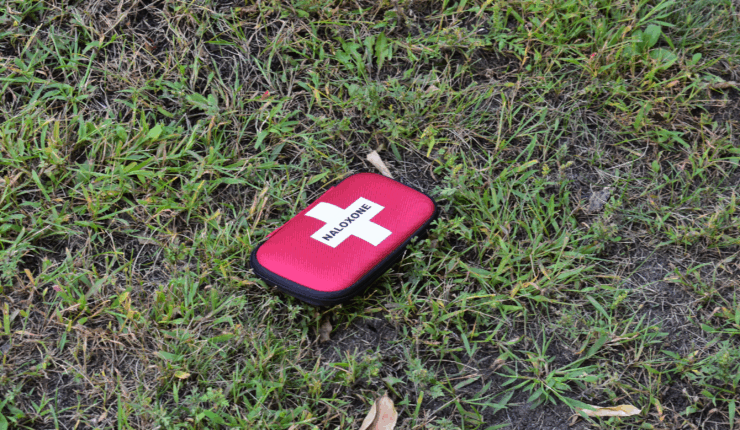Anyone can be prevented from an overdose
It is not news that the country has been living in an opioid epidemic for well over a decade, but people can struggle with substance use at any point in their life. A perfect storm of mental health issues, stressful environments, or a family history can make you especially vulnerable. A 2024 study found that one in four deaths among young people (those in their 20s and 30s) in 2021 were opioid-related.
Now imagine being a university student. Away from home for the first time and under various life pressures, students can be especially vulnerable due to factors such as high reported usage of substances (particularly alcohol), social pressures, and more. This is notable as the number of deaths from opioids among teenagers and young adults has tripled between 2014 and 2021.
Since this is a tense political topic and an emotional discussion among community members, different levels of government, community actors, and social institutions have implemented different responses to increasing harm reduction. For the provincial government, the move was to close safe consumption sites last summer, like Somerset West in Ottawa.
But for different post-secondary institutions, they have re-examined their campus health services, provided more resources to students, and took steps towards de-stigmatization. Yet…the University of Ottawa’s plans appear to be under wraps — if there are any.
What does campus harm reduction look like?
Harm reduction is defined as “an evidence-based, client-centred approach” with the goal of reducing “the health and social harms associated with addiction and substance use, without necessarily requiring people who use substances from abstaining or stopping,” according to the Canadian Mental Health Association (CMHA).
Last June, David Wai, the deputy minister of colleges and universities sent out a memo to 50 post-secondary institutions, urging them to review their harm reduction and overdose response strategies. This notice came following the death of University of Victoria student Sydney McIntyre-Stark last winter.
“We encourage institutions to collaborate on best practices, including for situations that require lifesaving emergency interventions, that are responsive to the needs of students with substance use issues and addictions,” the memo read.
Over the past decade, university campuses have implemented harm reduction information and resources into their existing health and wellness frameworks, alongside initiatives for healthy eating and mental health.
Carleton University’s ‘Umbrella Project’ has been praised for its comprehensiveness, accessibility, and rigidity. With nearly 30 naloxone boxes located across campus and training courses available for university students, staff and faculty, the efforts towards educating the community about harm reduction are apparent. First started as a two-year pilot project at Algonquin College in 2015, it has been adopted at Carleton University since 2019.
Dillon Brady, the manager of student conduct and harm reduction at Carleton University, was tasked with building out the harm reduction strategy on campus that eventually became a substance use health strategy. The change in terminology — as already adopted by Health Canada, the Canadian Center on Substance Use and Addiction, and various other organizations — was important to emphasize people’s broader social relationships with substances.
“The basic tenet is we all have a relationship with substances whether we choose to use them or not,” explained Brady. “
“Avoiding using a substance is still forming a relationship in that you’ve made the choice not to use it for whatever reason, whether that be religious, you know you’ve tried it or you’ve heard things about it that you don’t agree with, what have you. [B]ut we also have relationships with other people who have their own relationships with substances that also, in turn, impact us.”
“The other key piece of substance use health is so many people think I only need to seek help for my substance use when I have a problem. Substance use health encourages you to think and regularly check in on what your relationship with substances is.”
Brady went on to explain that his role often involves bringing together the various networks and connections between the groups on campus who have already been doing the work on promoting awareness on substance use health. He works closely in collaboration with the university’s health promotion team, Residence Life team, health and counseling team, campus safety, and even faculty members.
However, promoting substance use health at Carleton does not happen without its own challenges. Brady highlighted the importance of building meaningful relationships with stakeholders on campus and advocating for the value of the work being done, especially since funding for these causes can be limited.
“The role that universities play is interesting because we often don’t receive any direct funding from the province which is responsible for health care, for these types of initiatives, and sometimes there are pockets of grant funding. But the question I like to ask people is, if every university all of a sudden stopped offering health and counseling services or mental health supports, could the province handle all of that load?”
Brady has recently been working on implementing the Canadian post secondary drug and alcohol survey, to collect data on substance use on campus, as well as drafting a memorandum of understanding with the Canadian Center on Substance Use and Addiction for greater collaboration. He hopes for future increased collaboration and involvement from faculty within all disciplines.
“Our future goal is really to make Carleton a substance use health aware campus, and to then share that model out to other institutions in Ontario and in Canada, around what works,” explained Brady.
Mark Barnes is the pharmacist and owner of RespectRx, a pharmacy “dedicated to the respectable approach to complex mental health and substance use” in eastern Ontario. Barnes and his staff have been teaching, advocating, and supporting different communities regarding harm reduction and substance use since 2013 — including at the U of O.
“[We’ve] held over 1,000 seminars, [including] with the [U of O’s] school of medicine, with student services, with residence staff, with security staff for 10 years.”
Barnes highlights the importance of stigma-free, low-barrier access to Naloxone, calling it the “EpiPen for opioids”. He noted, “It’s easy to use and prevents the overdose — not just with people who intended to use opioids, but also due to how toxic our current drug supply is on the street, opioids find their way into other street drugs.”
“We’ve lost over 50,000 Canadians to an opioid overdose death since 2016. It’s the largest health emergency facing us, it’s an epidemic.”
Students are already looking out for each other
Regardless of study, students across campus are already taking initiative to teach each other harm reduction strategies — such as setting up naloxone training sessions.
The U of O’s Volunteer Crisis Response Team (VCRT) is one such campus group leading the effort to educate students on harm reduction, naloxone training and safe partying strategies. Lea Mortimer, an executive coordinator of VCRT and a third-year nursing student, says that overdose treatment and prevention is embedded into all types of VCRT training.
“When people are recruited into the team, they go through first responder training, which makes you qualified as a first responder,” Mortimer explained. “And there is a lot of training about opioid overdoses, overdoses of stimulants, any sort of harm reduction, drug-related calls and things like that.”
Mortimer highlighted the importance of not stigmatizing opiate users, and not to “associate it to a specific population”.
“Opioid overdoses, drug-related harm can affect anybody. It can be a professor, another one of your U of O colleagues — it can be anybody you know.”
“That’s something I love to see as a student. I feel more protected in the sense of, I know that if ever this were to happen to one of my colleagues, I’m happy to know that a lot of people will know what to do in those types of situations,” Mortimer confessed.
Mortimer also discussed VCRT’s plan for greater public education campaigns on campus, including education on harm reduction, thanks to the recently approved VCRT student levy.
“One of our big goals this year was to increase publication education. So [that way] not only us as first responders know how to respond to an overdose, but if at least the U of O student community would be able to recognize the signs of opioid overdose, know what to do, or who to call — that would be great for us.”
What is the U of O doing?
Barnes emphasizes that when it comes to establishing a harm reduction framework centred around opioid and drug use on campus, you need to have “100 per cent buy-in from the president down.”
“You have to have [an] education around naloxone. You have to have a partner willing to supply naloxone, and willing to buy it for institutions — if it’s for personal use, you go to a pharmacy, not for commercial use. You have to have a robust counselling program available for people who didn’t disclose to them they have a problem. And you need to have the buy-in of the security staff and emergency protocols on-site after.”
Barnes additionally highlights that, because of the U of O’s downtown location near supporting housing, shelters and substance use treatment centres, the university needs to make sure its “engaged with those community partners around keeping [the] campus safe”.
“You need to have naloxone boxes, and more education seminars, with and without public health. Your student union needs to be involved, especially around Panda Game and other vulnerable times,” Barnes went on. “You need to be a little more open-minded around harm reduction, and make sure you don’t bury your head in the sand, thinking that ‘oh, [we] don’t use substances’, because it is rampant.”
At the University of Ottawa, the Student Health and Wellness Sector has multiple teams who contribute to raising awareness on health and wellness topics, which include support for both mental health and substance use health.
“So we know that university life can be quite challenging for students, and it can put them at risk for greater substance use and also sometimes mental health challenges. So that’s why we really focus on informing students. We find that that’s really important to raise awareness and Rachel’s [Maclean] team [The Health Promotion and Education Team] does an amazing job to help talk about the risks and safety as well for students if they do choose to use substances,” explained Mélissa Lafrance, Manager of Psychotherapy and Mental Health Services.
With a team of over 70 student staff and volunteers, the Health Promotion and Education team walk around campus in blue shirts to raise awareness about health topics by talking to students. The team follows a wellness curriculum throughout the year, with one core section dedicated to harm reduction and another one on mental health.
Last year their team had over 27,000 interactions with students, with around 20 per cent of interactions focused on mental health and another 20 per cent focused on harm reduction. They increase their messaging on harm reduction especially near holidays like St Patrick’s Day or during dedicated mental health awareness months.
“Based on feedback that we received from our team of students, staff, and volunteers, we have seen an increased interest in substance use and understanding different harm reduction strategies, and particularly in relation to cannabis use.
And then from some data from our personalized health education program we’ve also seen more students coming booking appointments to learn more about, you know, how substance use might affect either their academics or some daily habits like sleep hygiene or stress management,” explained Rachel Maclean, Supervisor of Student Health and Wellness.
The stigma associated with substance use and mental health is one of the reasons why the Health Promotion Team especially focuses on building a safe and non-judgemental community on campus. Some of the programming dedicated to this includes hosting regular workshops and events, as well as making peer support sessions available to students.
“[O]ne of the reasons why the health promotion team has adopted the peer to peer model is to really help breakdown that stigma and for students to feel like they have someone that they can talk to and ask maybe some of those more challenging questions that they may be more reluctant to ask someone else about,” explained Lafrance.
The personalized health education program is another avenue where students can discuss their relationship with substance use or mental health in a non-judgemental environment with a Health Promotion Specialist who can direct them towards the appropriate resources and determine a tailored care plan.
It seems that partnerships for more targeted programming on substance use health may increase in the future as Maclean mentioned how the team recently partnered with Ottawa Public Health (OPH) to talk to students on campus about mental health, substance use, and community resources that students can access. OPH also provided Naloxone kits and training for students on campus, which garnered a lot of engagement and interest. Maclean mentioned they would be looking into continuing this initiative next year as well.
With substance use health becoming increasingly important and public funding becoming more precarious, universities are charged with the responsibility of ensuring students are well supported. While the U of O does focus on promoting awareness on harm reduction, there remains room for collaboration with community organizations who have done a lot of the ongoing work in harm reduction.
As the demand for substance use health resources increases, we can expect universities to continue playing a key role in ensuring students are well-informed on how they can build healthy relationships with substances and promote safe substance use.
The university did not respond to the Fulcrum’s request for comment in time for publication.
Resources for readers:
- The Royal’s Substance Use and Concurrent Disorders Program
- ConnexOntario – Drug Alcohol and Gambling Helpline
- Harm Reduction Services in Ottawa
- Readings on substance use health






